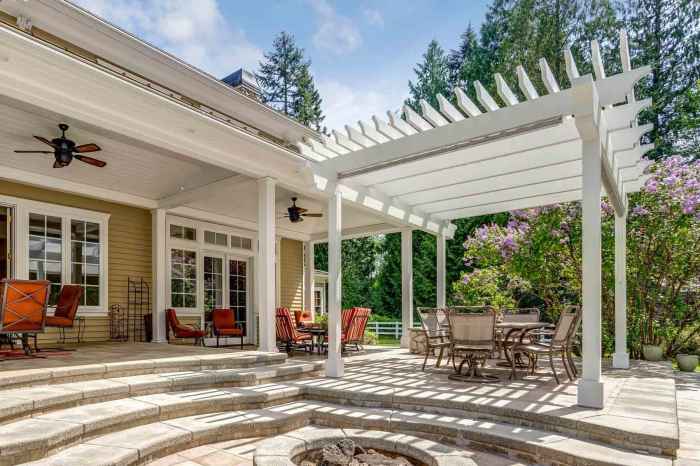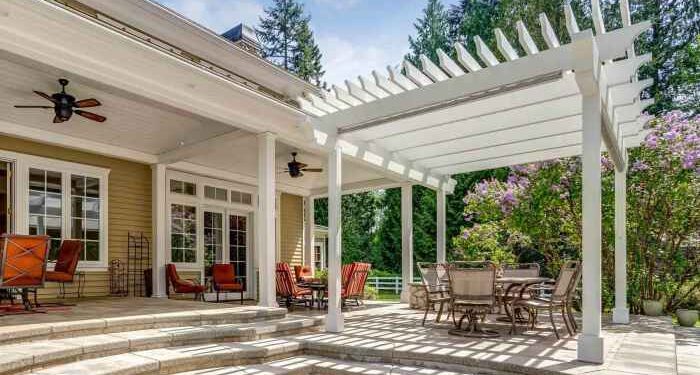Step into a world where outdoor living meets elegance with our pergola installation services. From adding value to your property to creating a serene oasis in your backyard, pergolas offer a multitude of benefits that transform your residential setting. Let's delve into the details of how pergolas can elevate your outdoor space to new heights.
Importance of Pergola Installation Services
Having a pergola in a residential setting offers numerous benefits that can enhance the overall quality of outdoor living spaces and increase property value. Pergolas are not only aesthetically pleasing but also provide functional advantages that make them a valuable addition to any home.
Benefits of Having a Pergola
- Shade and Protection: Pergolas offer a shaded area where you can relax and enjoy the outdoors without being exposed to direct sunlight. This provides protection from harmful UV rays and allows for comfortable outdoor gatherings even on hot days.
- Enhanced Outdoor Living: Pergolas create an inviting environment for outdoor activities such as dining, entertaining guests, or simply lounging with a good book. They serve as a focal point in the yard and can be customized with lighting, curtains, or climbing plants to suit your style.
- Increase Property Value: A well-designed and professionally installed pergola can significantly increase the overall value of your property. Potential buyers are often attracted to homes with outdoor living spaces that offer both functionality and aesthetic appeal.
Types of Pergolas for Installation

When it comes to pergola installation, there are various types of pergolas available to choose from. These types differ based on the materials used, construction style, and customizable features.
Materials Used for Pergola Construction
Pergolas can be constructed using different materials, each offering its own unique benefits and aesthetics. Common materials include:
- Wood: Provides a natural and rustic look, with options like cedar, pine, or redwood.
- Aluminum: Offers durability and low maintenance, ideal for modern and sleek designs.
- Vinyl: Known for its longevity and resistance to rot, termites, and weather damage.
- Fiberglass: Combines strength and versatility, allowing for intricate designs and shapes.
Freestanding vs. Attached Pergolas
- Freestanding Pergolas: Stand alone and can be placed anywhere in the outdoor space, providing a distinct focal point.
- Attached Pergolas: Connected to a structure like a house or building, extending the living space seamlessly.
Customizable Features Available for Pergolas
Pergolas can be customized to suit individual preferences and needs. Some customizable features include:
- Roofing options: Choose from open, closed, or partially covered roofs.
- Decorative elements: Add lattice panels, curtains, or climbing plants for a personalized touch.
- Size and shape: Customize the dimensions and shape of the pergola to fit the available space.
- Accessories: Incorporate lighting, fans, heaters, or retractable shades for added comfort and functionality.
Planning and Preparation
When it comes to installing a pergola, proper planning and preparation are essential to ensure a successful project. Here we will discuss the initial steps involved in planning a pergola installation, considerations for choosing the right location, and tips for preparing the installation site.
Choosing the Right Location
- Consider the purpose of the pergola - whether it's for shade, entertainment, or aesthetics.
- Take into account the direction of sunlight and prevailing winds to optimize comfort.
- Check for any underground utilities or obstacles that may affect the installation.
Preparing the Installation Site
- Clear the area of any debris, rocks, or vegetation that may hinder the installation process.
- Ensure the ground is level and stable to provide a sturdy base for the pergola.
- Mark the location of the pergola using stakes and string to visualize the layout before installation.
- Gather all necessary tools and materials beforehand to streamline the installation process.
Installation Process
Installing a pergola requires careful planning and precise execution to ensure a sturdy and visually appealing structure in your outdoor space. Let's go through the step-by-step process of installing a pergola.
Step 1: Site Preparation
- Clear the area where the pergola will be installed of any debris or obstacles.
- Mark the location where the posts will be placed, ensuring they are level and properly spaced.
Step 2: Assembly
- Assemble the pergola kit according to the manufacturer's instructions, making sure all components are securely connected.
- Attach the beams and rafters to the posts, ensuring they are level and correctly positioned.
Step 3: Installation
- Dig holes for the posts and pour concrete to secure them in place.
- Attach the assembled pergola to the posts, checking for stability and making any necessary adjustments.
Role of Professionals in Pergola Installation Services
Professionals play a crucial role in ensuring the successful installation of a pergola. Their expertise and experience help in avoiding common pitfalls and ensuring a sturdy and well-constructed structure. From site preparation to assembly and installation, professionals can handle every aspect of the process efficiently.
Common Challenges During Installation and How to Overcome Them
Installing a pergola may come with its own set of challenges, but with the right approach, they can be overcome. Some common challenges include uneven terrain, inclement weather, and logistical issues. To overcome these challenges, it is essential to plan ahead, have the right tools and equipment, and be prepared to adapt to unexpected circumstances.
By working with experienced professionals and staying flexible, you can ensure a smooth and successful installation process.
Maintenance and Care
Proper maintenance and care are essential to ensure the longevity and beauty of your pergola. By following some simple practices, you can keep your pergola in excellent condition for years to come.
Regular Maintenance Practices
- Inspect the structure regularly for any signs of damage, such as cracks or rot.
- Clean the pergola with a mild detergent and water to remove dirt and debris.
- Trim any nearby vegetation to prevent it from growing onto or damaging the pergola.
- Tighten any loose screws or bolts to ensure the structure remains stable.
Treating and Protecting Materials
- Apply a protective sealant or stain to wooden pergolas to prevent moisture damage and UV fading.
- Use rust-resistant coatings on metal pergolas to prevent corrosion.
- Regularly check for signs of wear and tear on all materials and address them promptly.
Seasonal Care and Cleaning
- In the spring, thoroughly clean the pergola and check for any winter damage.
- In the summer, trim back any overhanging branches and vines to prevent damage to the structure.
- In the fall, remove any debris that may have accumulated on the pergola to prevent mold growth.
- In the winter, ensure that the pergola is properly secured and protected from harsh weather conditions.
Conclusion
As we wrap up our discussion on pergola installation services, it's evident that these structures not only beautify your home but also provide a functional and inviting space for relaxation and entertainment. Whether you're looking to boost your property's value or simply enhance your outdoor living experience, a pergola is a versatile addition that brings both aesthetic appeal and practicality to your surroundings.
FAQ Insights
What are the benefits of having a pergola in a residential setting?
Having a pergola adds value to your property, creates a beautiful outdoor space for relaxation, and enhances the overall aesthetic appeal of your home.
What materials are commonly used for pergola construction?
Common materials include wood, aluminum, and vinyl, each offering different aesthetics and durability.
What steps are involved in planning a pergola installation?
The initial steps include deciding on the location, obtaining necessary permits, and determining the size and design of the pergola.
How can I maintain my pergola in good condition?
Regular maintenance such as cleaning, checking for damage, and applying protective coatings can keep your pergola in top condition.










